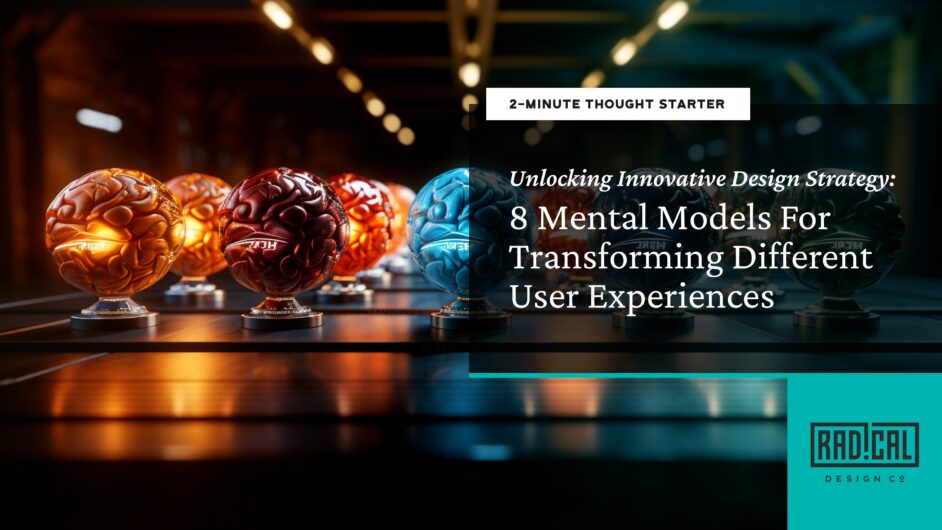Unlocking Innovative Design Strategy: 8 Mental Models to Transform Different User Experience Needs
Harness the power of innovative design with 8 mental models tailored for the digital age. Dive into strategies to help you navigate AI, VR, and AR complexities, ensuring intuitive, user-centric solutions. Unleash creativity and precision in every design decision, balancing visual appeal and engagement.

We are in a fast-paced digital environment where people are being exposed to innovation all over the place: multi-modal designs, virtual reality (VR), augmented reality (AR), and artificial intelligence (AI), to name a few. While expanding the horizons and capabilities of products and services for user experiences, these innovations have also introduce complexities requiring refined design strategies and tools to ensure success.
In comes Design Strategy Mental Models to save the day. These structured and systematic frameworks aid in understanding and addressing complex user behaviors and needs, ensuring clear and actionable insights for intuitive and user-centric design solutions.
For example, using a mental model called “First Principle Thinking,” a design strategist working on an e-commerce platform might break down the UX of an online shopping experience into its fundamental elements to understand the cognitive processes users go through when shopping online. This Mental Model helps separate assumptions from core truths, focuses on the foundational aspects of user experience, and aligns the experience with users’ natural behaviors and expectations, making the process truly seamless and enjoyable.
“First Principle Thinking” is just one of many different Mental Models that can be used to make powerful experiences for users, consumers, employees, and more in this ever-complex and evolving innovative environment.
Let’s look take a high-level look at Eight (8) Design Strategy Mental Models and when you might use them to enhance quality crafted experiences.
-
First Principle Thinking in Design
Break down the design problem into fundamental elements, focusing on the core issues. Discard assumptions and rebuild solutions from the ground up. Here is a step-by-step view of the process:
- Identify the core problem.
- Deconstruct the issue into essential elements.
- Eliminate assumptions.
- Reassemble components to create innovative solutions.
When To Use Example: Users find the current e-commerce platform’s navigation complex and unintuitive, leading to decreased user engagement and increased cart abandonment. Use First Principle Thinking and deconstruct the online shopping experience into essential elements to reconstruct a user interface that aligns with natural user behaviors, enhancing navigation and product discovery.
-
Second-Order Thinking in Design
Focus on the long-term effects of design decisions beyond immediate outcomes. Here is a step-by-step view of the process:
- Identify the immediate effects of a design decision.
- Explore potential long-term impacts.
- Weigh the pros and cons.
- Optimize for sustainable positive outcomes.
When To Use Example: Introducing a new feature increases immediate user engagement but has yet to be assessed for its impact on long-term user retention. Use Second-Order Thinking and evaluate the long-term effects of the new feature to ensure it not only boosts initial engagement but also promotes sustained usage over time.
-
UX Opportunity Costs
Weigh the trade-offs in design decisions, considering what is sacrificed and gained. Here is a step-by-step view of the process:
- List all design options.
- Evaluate the potential gains and losses of each.
- Compare the overall impact.
- Choose the option with optimal balance.
When to Use Example: A product team must decide whether to prioritize advanced features or a minimalist design to enhance user experience. Use UX Opportunity Costs to opt for simplicity in design, improving usability at the expense of intricate visual elements.
-
Design Randomness
Acknowledge unpredictability and test various design elements. Here is a step-by-step view of the process:
- Create diverse design elements.
- Implement A/B testing.
- Analyze user responses.
- Adapt design based on feedback.
When to Use Example: Your current website design is not effectively catering to the diverse preferences of your user base. Implement the Design Randomness model and A/B test various elements to ensure you have the right content and designs to cater to unpredictable user preferences.
-
Strategy Leverage
Maximize existing resources to enhance the user experience. Here is a step-by-step view of the process:
- Identify available resources.
- Explore how to amplify their impact.
- Implement enhancements.
- Monitor and optimize based on feedback.
When to Use Example: Your SaaS platform needs to enhance user engagement without undergoing a complete overhaul. Use Strategy Leverage to consider how your SaaS platform could integrate AI-based personalized recommendations to improve engagement without a complete system revamp.
-
Margin of Safety
Incorporate adaptability to cater to errors and changes. Here is a step-by-step view of the process:
- Identify potential errors or changes.
- Design with flexibility to accommodate these.
- Test adaptability.
- Make necessary adjustments.
When To Use Example: Your mobile app’s layout is not displaying optimally across different screen sizes, affecting user engagement. Use Margin of Safety thinking to create an adaptive structure that ensures optimal display and functionality across various screen sizes.
-
Law of Diminishing Returns
Recognize when adding more elements ceases to add significant value. Here is a step-by-step view of the process:
- Identify key design elements.
- Assess the impact of additional components.
- Determine the optimal balance.
- Eliminate or reduce excess.
When To Use Example: Increasing the number of calls-to-action (CTAs) on the webpage has yet to lead to a proportionate increase in user engagement for your corporate website. Leverage the Law of Diminishing Returns to optimize the number of CTAs to maximize engagement without overwhelming your users.
-
Strategy Niches
Customize designs to meet the specific needs of targeted user groups. Here is a step-by-step view of the process:
- Identify target user groups.
- Understand their specific needs and preferences.
- Tailor design elements accordingly.
- Test and refine for optimal satisfaction.
When to Use Example: The generic interface design that you out-of-box implemented is not effectively meeting the specific needs of your elderly target user population. Think through Strategy Niches that can assist in crafting a specialized app interface focusing on ease of navigation and readability for your older people.
So, having outlined these mental models, the pressing question emerges: “What’s the real-world implication of all this?” These models are not abstract concepts detached from reality. Instead, they’re practical tools that can transform the landscape of your experiences, breathing life and efficiency into every interaction. Employing these mental models means you’re approaching experiences with a Quality Crafted, Mission Driven Design strategy mind. It’s a step beyond the norm, into a place where each design decision is intentional to improve visual appeal and overall engagement. This is where authentic design and user experience innovation resides.
Intrigued?
More Thought Starters

Thought Starters
A Design Strategy Perspective: Crafting Corporate Policies for AI Use

Thought Starters
The Future of Project Management: Embracing AI as an Empowerment Tool

Thought Starters